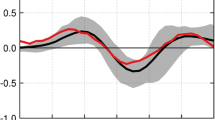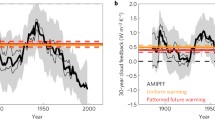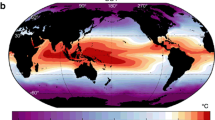Abstract
Clouds are sensitive to changes in both the large-scale circulation and the thermodynamic structure of the atmosphere. In the tropics, temperature changes that occur on seasonal to decadal time scales are often associated with circulation changes. Therefore, it is difficult to determine the part of cloud variations that results from a change in the dynamics from the part that may result from the temperature change itself. This study proposes a simple framework to unravel the dynamic and non-dynamic (referred to as thermodynamic) components of the cloud response to climate variations. It is used to analyze the contrasted response, to a prescribed ocean warming, of the tropically-averaged cloud radiative forcing (CRF) simulated by the ECMWF, LMD and UKMO climate models. In each model, the dynamic component largely dominates the CRF response at the regional scale, but this is the thermodynamic component that explains most of the average CRF response to the imposed perturbation. It is shown that this component strongly depends on the behaviour of the low-level clouds that occur in regions of moderate subsidence (e.g. in the trade wind regions). These clouds exhibit a moderate sensitivity to temperature changes, but this is mostly their huge statistical weight that explains their large influence on the tropical radiation budget. Several propositions are made for assessing the sensitivity of clouds to changes in temperature and in large-scale motions using satellite observations and meteorological analyses on the one hand, and mesoscale models on the other hand.









Similar content being viewed by others
Notes
Although we use, in practice, finite intervals of ω of 10 hPa/day to define dynamical regimes, we will consider in the following notations that ω intervals are infinitesimal
The discretized form of this equation, that is used in practice here, is of the form: \( \overline{\delta C} = \sum\nolimits_\omega {C_\omega \Delta P_\omega} + \sum\nolimits_\omega {P_\omega \Delta C_\omega} + \sum\nolimits_\omega {\Delta P_\omega \Delta C_\omega } \)where ΔC ω and ΔP ω refer to the changes in C ω and P ω
The change in cloudiness that occurs in a particular region of the tropics may result from both local and remote influences. At first approximation, if one considers that the remote effects are felt by clouds mostly through changes in the large-scale atmospheric motion, then the changes in cloud properties that occur for a given dynamical regime (the thermodynamic component) can be considered as being much less dependent on remote effects. We insist however that this is only an approximation: remote effects may affect clouds through other factors than a change in ω (a change in the temperature lapse rate, the occurrence of dry intrusions in the mid troposphere, etc)
Note that the change in ω that occurs in a given region results from both local and remote influences
For the current climate, Sud et al. (1999) suggested these temperature thresholds to be constrained by the relationship between the vertical profiles of dry and moist static energy in the tropical atmosphere. Figure 8 suggests that the SST thresholds derived from this relationship might depend on the mean tropical temperature
The reason for the decrease of convective activity or large-scale convergence at very high temperatures, pointed out and characterized by Waliser and Graham (1993) and Waliser (1996), is still a matter of study: it has been proposed that it could be related to the subsidence induced by remote forcings such as the large-scale subsidence associated by intraseasonal waves over the warm pool (Bony et al. 1997; Lau et al. 1997), or by a positive feedback between tropical convection and water vapour (Tompkins 2001)
Large-scale motions are sensitive to horizontal gradients in the boundary-layer entropy (Lindzen and Nigam 1987, Emanuel et al. 1994). The relationship between SST and boundary-layer entropy, and its link to the sharp increase of deep convection for SSTs above 26 °C are discussed by Sud et al. (1999) and Folkins and Braun (2003)
References
Allan RP, Slingo A (2002) Can current climate model forcings explain the spatial and temporal signatures of decadal olr variations? Geophys Res Lett 29: 10,1029–10,1032
Allan RP, Slingo A, Ringer MA (2002) Influence of dynamics on the changes in tropical cloud radiative forcing during the 1998 El-Niño. J Clim 15: 1979–1986
Barkstrom BR (1984) The Earth Radiation Budget Experiment (ERBE). Bull Am Metropol Soc 65: 1170–1185
Bony S, Collins WC, Fillmore D (2000) Indian ocean low clouds during the winter monsoon. J Clim 13: 2028–2043
Bony S, Lau K-M, Sud YC (1997) Sea surface temperature and large-scale circulation influences on tropical greenhouse effect and cloud radiative forcing. J Clim 10: 2055–2077
Bretherton CS, Sobel AH (2002) A simple model of a convectively coupled Walker circulation using the weak temperature gradient approximation. J Clim 15: 2907–2920
Chen J, Carlson BE, Del Genio AD (2002) Evidence for strengthening of the tropical general circulation in the 1990s. Science 295: 838–841
Chéruy F, Chevallier F (2000) Regional and seasonal variations of the clear sky atmospheric longwave cooling over tropical oceans. J Clim 13: 2863–2875
CLIMAP Project Members (1981) Seasonal reconstruction of the earths surface at the last glacial maximum. Map and Chart Series, 18 pp, Geological Society of America
Coakley JA, Baldwin DG (1984) Towards the objective analysis of clouds from imagery data. J Clim Appl Meteorol 23: 1065–1099
Del Genio AD, Kovari W (2002) Climatic properties of tropical precipitating convection under varying environmnetal conditions. J Clim 15: 2597–2615
Del Genio AD, Yao M-S, Kovari W, Lo KK-W (1996) A prognostic cloud water parametrization for global climate models. J Clim 9: 270–304
Dhuria HL, Kyle HL (1990) Cloud types and the tropical earth radiation budget. J Clim 3: 1409–1434
Emanuel KA (1994) Atmospheric convection. Oxford University Press, Oxford, UK
Emanuel KA, Pierrehumbert RT (1996) Microphysical and dynamical control of tropospheric water vapour. In: Crutzen PJ, Ramanathan V (eds) Clouds, Chemistry, and Climate. Springer-Berlin, Heidelberg, New York, pp 264
Emanuel KA, Zivkovic-Rothman M (1999) Development and evaluation of a convection scheme for use in climate models. J Atmos Sci 56: 1766–1782
Emanuel KA, Neelin JD, Bretherton CS (1994) On large-scale circulations in convecting atmospheres. Q J R Meteorol Soc 120: 1111–1143
Folkins I, Braun C (2003) Tropical rainfall and boundary layer moist entropy. J Clim 16: 1807–1820
Fu Q, Baker M, Hartmann DL (2002) Tropical cirrus and water vapour: an effective Earth infrared iris? Atmos Chem Phys 2: 31–37
GEWEX Cloud System Science Team (1993) The GEWEX Cloud System Study (GCSS). Bull Am Meteorol Soc 74: 387–389
Gibson JK, Kallberg P, Uppala S, Noumura A, Hernandez A, Serrano E (1997) ERA description. ECMWF Re-Analysis Project Report Series 77 pp ECMWF, Reading, UK
Hartmann DL, Michelsen ML (1993) Large-scale effects on the regulation of tropical sea surface temperature. J Clim 6: 2049–2062
Hartmann DL, Moy LA, Fu Q (2001) Tropical convection and the energy balance at the top of the atmosphere. J Clin 14: 4495–4511
Kalnay E and co authors (1996) The NCEP/NCAR 40-year reanalysis project. Bull Am Meteorol Soc 77: 437–471
Klein SA, Hartmann DL (1993) The seasonal cycle of low stratiform clouds. J Clim 6: 1587–1606
Klein SA, Jakob C (1999) Validation and sensitivities of frontal clouds simulated by the ECMWF model. Mon Weather Rev 127: 2514–2531
Larson K, Hartmann DL, Klein SA (1999) The role of clouds, water vapour, circulation, boundary layer structure in the sensitivity of the tropical climate. J Clim 12: 2359–2374
Lau K-M, Sui CH, Chou MD, Tau WK (1994) An inquiry into the cirrus-thermostat effect for tropical sea surface temperature. Geophys Res Lett 21: 1157–1160
Lau K-M, Wu HT, Bony S (1997) The role of large-scale atmospheric circulation in the relationship between tropical convection and sea surface temperature. J Clim 10: 381–392
LeTreut H, McAvaney B (2000) A model intercomparison of equilibrium climate change in response to CO2 doubling. Note du Pôle de Modélisation de l’IPSL, 2000
Levitus S, Antonov JI, Boyer TP, Stephens C (2000) Warming of the world ocean. Science 287: 2225–2229
Lin B, Wielicki BA, Chambers LH, Hu Y, Xu K-M (2002) The Iris hypotehsis: a negative or positive cloud feedback? J Clim 15: 3–7
Lindzen RS, Nigam S (1987) On the Role of Sea Surface Temperature Gradients in Forcing Low-Level Winds and Convergence in the tropics. J Atmos Sci 44: 2418–2436
Lindzen RS, Chou MD, Hou AY (2001) Does the Earth have an adaptative infrared iris? Bull Am Meteorol Soc 82: 417–432
Miller RL (1997) Tropical thermostats and low cloud cover. J Clim 10: 409–440
Morcrette J-J (1991) Evaluation of model-generated cloudiness: satellite observed and model generated diurnal variability of brightness temperature. Mon Weather Rev 119: 1205–1224
Norris JR (1998) Low cloud type over the ocean from surface observations. Part II: geographical and seasonal variations. J Clim 11: 383–403
Norris JR, Weaver CP (2001) Improved techniques for evaluating GCM cloudiness applied to the NCAR CCM3. J Clim 14: 2540–2550
Pierrehumbert RT (1995) Thermostats, radiator fins, the local runaway greenhouse. J Atmos Sci 52: 1784–1806
Pierrehumbert RT, Roca R (1998) Evidence for control of atlantic subtropical humidity by large scale advection. Geophys Res Lett 25: 4537–4540
Pope VD, Gallani ML, Rowntree PR, Stratton RA (2000) The impact of new physical parametrizations in the Hadley Centre climate model. Clim Dyn 16: 123–146
Ramanathan V, Collins W (1991) Thermodynamic regulation of ocean warming by cirrus clouds deduced from observations of the 1987 el-niño. Nature 351: 27–32
Salathe E, Hartmann DL (1997) A trajectory analysis of tropical upper-tropospheric moisture and convection. J Clim 10: 2533–2547
Schubert SD, Pfaendtner J, Rood R (1993) An assimilated dataset for Earth science applications. Bull Am Meteorol Soc 74: 2331–2342
Sud YC, Walker GK, Lau KM (1999) Mechanisms regulating sea surface temperatures and deep convection in the tropics. Geophys Res Lett 26: 1019–1022
Tompkins AM (2001) On the relationship between tropical convection and sea surface temperature. J Clim 14: 633–637
Tompkins AM, Craig GC (1999) Sensitivity of tropical convection to sea surface temperature in the absence of large-scale flow. J Clim 12: 462–476
Waliser DE (1996) Formation and limiting mechanism for very high sst: linking the dynamics and thermodynamics. J Clim 9: 161–188
Waliser DE, Graham NE (1993) Convective cloud systems and warm-pool sea surface temperatures: coupled interactions and self-regulation. J Geophys Res 98: 12,881–12,893
Webb M, Senior C, Bony S, Morcrette J-J (2001) Combining ERBE and ISCCP data to assess clouds in the Hadley Centre. ECMWF and LMD atmospheric climate models. Clim Dyn 17: 905–922
Wielicki BA, Wong T, Allan RP, Slingo A, Kiehl JT, Soden BJ, Gordon CT, Miller AJ, Yang, S-K, Randall DA, Robertson F, Susskind J, Jacobowitz H (2002) Evidence for large decadal variability in the tropical mean radiative energy budget. Science 295: 841–844
Williams KD, Ringer MA, Senior CA (2003) Evaluating the cloud response to climate change and current climate variability. Clim Dyn 20:705–721
Wu X, Moncrieff MW (1999) Effects of sea surface temperature and large-scale dynamics on the thermodynamic equilibrium state and convection over the tropical western pacific. J Geophys Res 104(D6): 6093–6100
Wu X, Hall WD, Grabowski WW, Moncrieff MW, Collins WD, Kiehl JT (1999) Long-term behavior of cloud systems in TOGA COARE and their interactions with radiative and surface processes. Part II: effects of cloud microphysics on cloud-radiation interaction. J Geophys Res 56: 3177–3195
Yao M-S, Del Genio AD (2001) Effects of cloud parameterization on the simulation of climate changes in the GISS GCM. Part II: sea surface temperature and cloud feedbacks. J Clim 15: 2491–2503
Yin JH, Battisti DS (2001) The importance of tropical sea surface temperature patterns in simulations of last glacial maximum climate. J Clim 14: 565–581
Yu W, Doutriaux M, Sèze G, LeTreut H, Desbois M (1996) A methodology study of the validation of clouds in GCMs using ISCCP satellite observations. Clim Dyn 12: 389–401
Acknowledgements.
This work benefited from discussions with Kerry Emanuel, Jean-Yves Grandpeix, Christian Jakob, Laurent Li, Mark Webb and Yun-Ichi Yano, and from comments by anonymous reviewers. Part of this study was supported by the Environmental Program of the Commission of the European Communities (project ENV4-CT95-0126 entitled Cloud Feedbacks and Validation). French participants acknowledge the Programme National d’Etude Du Climat (PNEDC).
Author information
Authors and Affiliations
Corresponding author
Rights and permissions
About this article
Cite this article
Bony, S., Dufresne, JL., Le Treut, H. et al. On dynamic and thermodynamic components of cloud changes. Climate Dynamics 22, 71–86 (2004). https://doi.org/10.1007/s00382-003-0369-6
Received:
Accepted:
Published:
Issue Date:
DOI: https://doi.org/10.1007/s00382-003-0369-6




